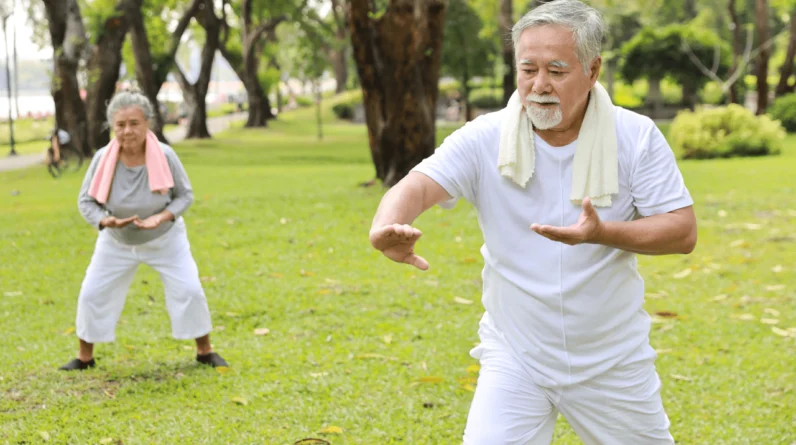
Life can feel so overwhelming sometimes, can’t it?
Between work deadlines, family commitments, and the endless ping of notifications, stress builds up faster than we can hit snooze on our alarms.
If this sounds familiar, let me introduce you to a game-changer: mindful movement, specifically Tai Chi and Qigong.
These ancient practices are like a breath of fresh air for your mind, body, and spirit.
Let’s dive into what makes them so powerful and how they can help you manage stress while cultivating a deeper sense of balance and well-being.
A Little Backstory: Where Tai Chi and Qigong Began
First, a quick history lesson.
Tai Chi (pronounced “tie-chee”) began in China as a martial art designed for self-defense. Over time, it evolved into a practice focused on health, relaxation, and spiritual development.
Its movements are slow and flowing, almost like a graceful dance. But underneath that serene exterior is a system rooted in Taoist philosophy and traditional Chinese medicine. It’s about finding harmony in the push and pull of life—yin and yang.
Qigong (pronounced “chee-gong”) is even older, with origins dating back over 4,000 years. Think of it as a mix of meditation, breathing exercises, and gentle movement, all designed to cultivate “Qi,” or life energy.
The goal?
To help your body heal itself, balance your emotions, and connect with the natural rhythms of the universe. It’s like hitting the ultimate reset button for your entire being.
Why Mindful Movement is a Stress-Buster
Stress wreaks havoc on our bodies.
It triggers that infamous fight-or-flight mode, leaving us feeling frazzled, tense, and downright exhausted. Tai Chi and Qigong work like magic to counteract this. Here’s how:
Calming Your Nervous System
When you practice these movements, your brain sends out a “we’re safe” signal to your body. Your heart rate slows down, your muscles relax, and your breath deepens.
This shifts you out of fight-or-flight and into a much-needed rest-and-recharge mode.
Mind Over Matter
The beauty of Tai Chi and Qigong is how they combine physical movement with focused awareness. You’re not just exercising; you’re fully present, paying attention to how your body feels as it moves.
This mindfulness helps quiet mental chatter and keeps you grounded in the here and now.
Benefits You Can Feel
So what does this look like in real life? Well, the benefits are pretty incredible:
For Your Body
You’ll notice improved flexibility, balance, and strength. Regular practice can even ease joint pain and lower your blood pressure. Plus, those flowing movements are gentle enough for all fitness levels, making them accessible to everyone.
For Your Mind
Practicing Tai Chi and Qigong is like giving your brain a spa day. It reduces anxiety, boosts your mood, and helps you sleep better. Seriously, who doesn’t want that?
For Your Spirit
This is where the magic deepens. These practices invite you to tune into your inner energy and feel more connected—to yourself, to others, and even to something greater.
Whether you call it nature, the universe, or the divine, that sense of connection is profoundly healing.
How to Get Started
Ready to give it a try? Here’s how you can dip your toes into the world of mindful movement:
Find a Class
Look for local or online Tai Chi or Qigong classes. Many instructors offer beginner-friendly sessions, so you don’t need any prior experience.
Start Small
Begin with just 10 minutes a day. Focus on simple, easy-to-follow movements. Even a little practice can make a big difference.
Make it a Ritual
Pair your practice with another calming habit, like journaling or sipping tea. Creating a routine helps it become a natural part of your day.
A Personal Perspective
Let me share a quick story.
A friend of mine started practicing Tai Chi during a particularly stressful time in her life. At first, she was skeptical. “It’s just moving slowly—how is this going to help me?” she said.
But after a few weeks, she noticed something shifting. She was sleeping better, her mind felt clearer, and she wasn’t snapping at her kids as much. “It’s like my body and mind finally learned how to breathe again,” she told me.
That’s the thing about Tai Chi and Qigong—they sneak up on you. The benefits may start subtly, but over time, they ripple through every part of your life.
Basic Tai Chi Postures and Movements for Beginners
- Wu Ji (Starting Posture)
- Stand with your feet shoulder-width apart, knees slightly bent, and arms resting naturally at your sides.
- Relax your shoulders and keep your back straight, imagining a string gently pulling the top of your head upward.
- Breathe deeply and focus on grounding yourself, feeling your connection to the earth beneath you.
- Wave Hands Like Clouds
- Begin with your feet a little wider than shoulder-width apart. Shift your weight onto one foot and turn your torso gently in that direction.
- As you turn, let one hand sweep across your body at shoulder height, palm facing in, while the other hand relaxes near your waist.
- Shift your weight to the other foot, turning your torso the opposite way, and switch your arms’ positions in a smooth, continuous motion.
- Imagine your hands softly brushing through the air, like clouds floating by.
These two simple movements are easy to practice and offer a calming introduction to Tai Chi. Pair them with deep, even breaths, and you’ll quickly start to feel more relaxed and centered.
Qigong Meditation Techniques for Beginners
- Belly Breathing (Dan Tian Breathing)
- What to Do: Sit or stand comfortably with your back straight and hands resting gently on your lower abdomen (just below your navel). Close your eyes or soften your gaze.
- The Practice: Inhale deeply through your nose, allowing your breath to expand your belly outward. Imagine filling your lower abdomen with warm, healing energy. As you exhale through your mouth, gently contract your belly, visualizing any tension or stress being released.
- Why It Helps: This technique activates your body’s relaxation response and focuses your mind, calming the nervous system and improving your connection to your inner energy (Qi).
- The Inner Smile
- What to Do: Sit comfortably, close your eyes, and take a few deep breaths to center yourself. Start by visualizing a warm, radiant smile in your heart.
- The Practice: Imagine that smile spreading throughout your body, one area at a time—your face, neck, shoulders, chest, arms, abdomen, and legs. As you focus on each area, release any tension and let the warmth of the smile fill that space.
- Why It Helps: This practice nurtures self-compassion and inner peace while promoting a gentle flow of positive energy throughout the body. It’s great for relieving stress and cultivating gratitude.
Both of these meditations are simple yet powerful ways to reconnect with yourself and foster a sense of balance and harmony. Start with just five to ten minutes a day and notice how they leave you feeling more relaxed and centered.
Take the Leap
Life doesn’t have to be a whirlwind of stress and chaos.
Tai Chi and Qigong offer a chance to slow down, reconnect, and rediscover a sense of peace. They’re not just exercises; they’re a way to nurture yourself, inside and out.
So why not give it a shot? Try a simple routine today. Your mind, body, and spirit will thank you for it.
If you’re curious and ready to explore Tai Chi or Qigong, the good news is that you don’t need fancy equipment or expensive classes to start.
YouTube is a treasure trove of free videos and tutorials.
Channels like these offer beginner-friendly lessons that guide you through the basics at your own pace.
Whether you’re looking for a gentle 10-minute routine or a deeper dive into these practices, there’s something for everyone.
So grab some comfy clothes, clear a little space, and let these videos help you take your first steps toward mindful movement and a calmer, more centered you.
Take a deep breath, step into the flow, and see where it takes you.







